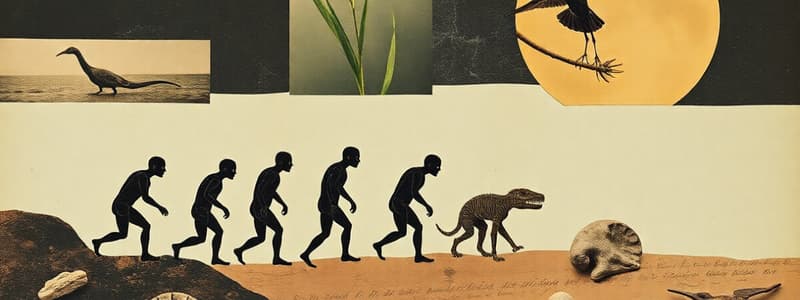Podcast
Questions and Answers
Which government agency is primarily responsible for the protection of natural and wildlife resources?
Which government agency is primarily responsible for the protection of natural and wildlife resources?
- PAGASA
- DENR (correct)
- PHIVOLCS
- DAR
A group of trout living in a particular stream, capable of interbreeding, is best described as what?
A group of trout living in a particular stream, capable of interbreeding, is best described as what?
- Population (correct)
- Biodiversity
- Environment
- Ecosystem
What term describes the maximum number of individuals in a population that an environment can sustainably support?
What term describes the maximum number of individuals in a population that an environment can sustainably support?
- Limiting Factor
- Carrying capacity (correct)
- Population density
- Population size
When a population exceeds its carrying capacity and some individuals leave to find new areas with sufficient resources, this is known as:
When a population exceeds its carrying capacity and some individuals leave to find new areas with sufficient resources, this is known as:
A river ecosystem is consistently polluted with garbage and toxic waste from nearby industries. What is the most likely long-term consequence for the river?
A river ecosystem is consistently polluted with garbage and toxic waste from nearby industries. What is the most likely long-term consequence for the river?
Which statement is NOT a characteristic of the evolutionary process?
Which statement is NOT a characteristic of the evolutionary process?
In which geological Era are the oldest fossils most likely to be discovered?
In which geological Era are the oldest fossils most likely to be discovered?
Which characteristic provides the most definitive evidence of a close evolutionary relationship between two organisms?
Which characteristic provides the most definitive evidence of a close evolutionary relationship between two organisms?
Which argument best supports the statement that extinction is a necessary process in the history of life?
Which argument best supports the statement that extinction is a necessary process in the history of life?
Which of the following best describes Lamarck's Theory of Use and Disuse?
Which of the following best describes Lamarck's Theory of Use and Disuse?
The theory of natural selection primarily asserts that:
The theory of natural selection primarily asserts that:
Which pair of animal structures is a correct example of homologous structures?
Which pair of animal structures is a correct example of homologous structures?
Why do organisms with close biochemical similarities generally exhibit stronger evolutionary relationships?
Why do organisms with close biochemical similarities generally exhibit stronger evolutionary relationships?
Flashcards
DENR
DENR
The government agency in charge of protecting natural and wildlife resources.
Population
Population
A group of organisms of the same species living in a specific area.
Carrying Capacity
Carrying Capacity
The maximum number of individuals a habitat can sustainably support.
Emigration
Emigration
Signup and view all the flashcards
Ecosystem
Ecosystem
Signup and view all the flashcards
What is Evolution?
What is Evolution?
Signup and view all the flashcards
Pre-Cambrian Era
Pre-Cambrian Era
Signup and view all the flashcards
Genomic DNA Similarity
Genomic DNA Similarity
Signup and view all the flashcards
Necessity of Extinction
Necessity of Extinction
Signup and view all the flashcards
Theory of Use and Disuse
Theory of Use and Disuse
Signup and view all the flashcards
Natural Selection Theory
Natural Selection Theory
Signup and view all the flashcards
Homologous Structures
Homologous Structures
Signup and view all the flashcards
Habitat Loss Effects
Habitat Loss Effects
Signup and view all the flashcards
Study Notes
- Evolution involves change and is a continuous process.
- The idea that the world is stable and unchanging does not describe evolution.
- Mutation leads to evolution.
- The oldest fossils are found in the Pre-Cambrian Era.
- Similarity in genomic DNA is a more definitive characteristic to show the relatedness of two organisms.
- Extinction allows other organisms to develop, evolve and progress.
Theories
- The Theory of Use and Disuse states that organs not in use will disappear, while organs in use will develop.
- The Theory of Natural Selection says that only the fittest organisms will survive in a given environment.
Homologous Structures and Evolutionary Relationships
- Flipper of whale and forelimb of cat are examples of homologous structures.
- Body structures develop because they are used extensively, according to Lamarck’s Theory of Use and Disuse.
- Organisms with close biochemical similarities show stronger evolutionary relationships as they share a common ancestor and have the same kind of proteins.
Threats to Wildlife and Biodiversity
- Loss of habitat is a major cause of decreasing wildlife populations.
- Direct economic value refers to the value of species as sources of food, medicine, clothing, shelter, and energy.
- Biodiversity describes how varied life forms are in different ecosystems.
- DENR (Department of Environment and Natural Resources) is the agency responsible for protecting natural and wildlife resources.
- A population is a group of organisms of the same species living in a certain area.
- Carrying capacity is the maximum number of a population an environment can support.
- Emigration occurs when a population approaches its carrying capacity, and organisms leave to find resources elsewhere.
- An ecosystem is a community of organisms that live, feed, and interact with the environment.
- Limiting factors control the growth of a population.
- Davao's wide variety of fruits demonstrates the direct economic and ethical/cultural value of biodiversity.
Environmental Issues and Population Dynamics
- Dumping garbage and toxic waste into a river ecosystem will cause it to become a wasteland.
- The population will decrease when guinea pigs are aggressive towards each other, the young are less healthy and more young guinea pigs die.
Studying That Suits You
Use AI to generate personalized quizzes and flashcards to suit your learning preferences.
Description
Explore evolution's continuous change, driven by mutation and natural selection. Discover the Theory of Use and Disuse and how the fittest organisms survive. Learn about homologous structures and genomic DNA in determining evolutionary relationships.




